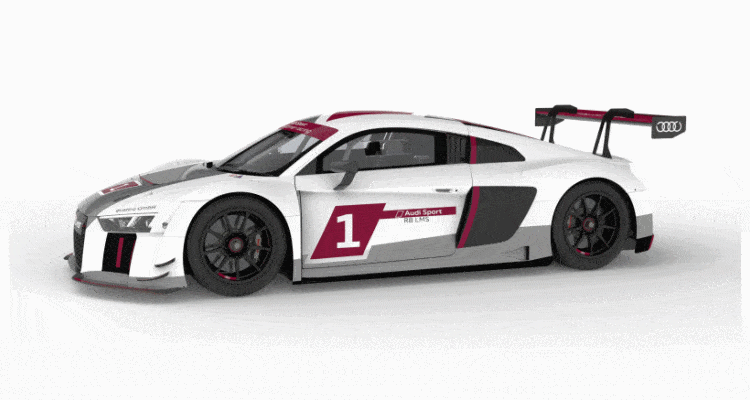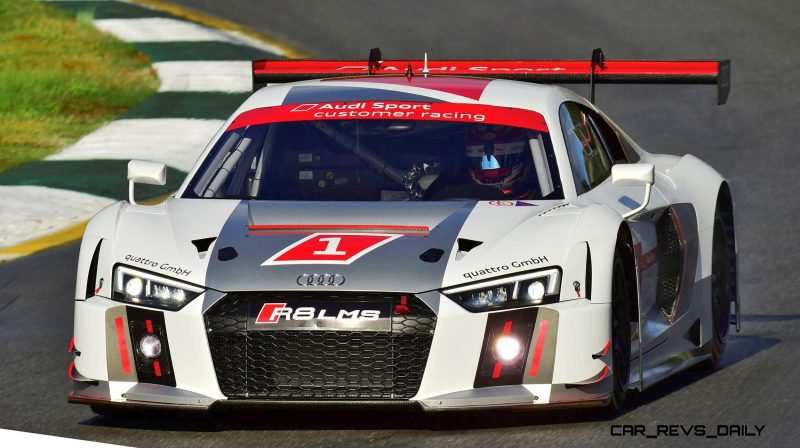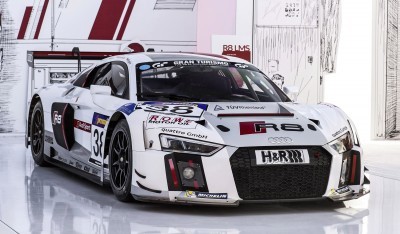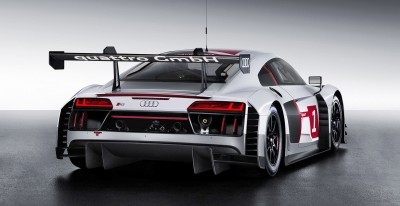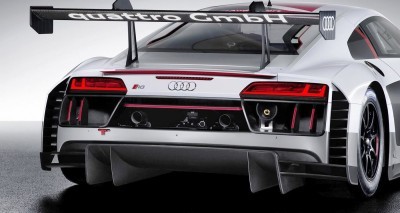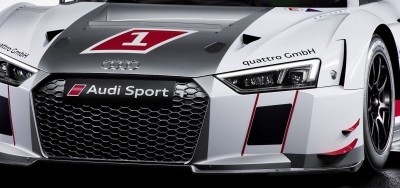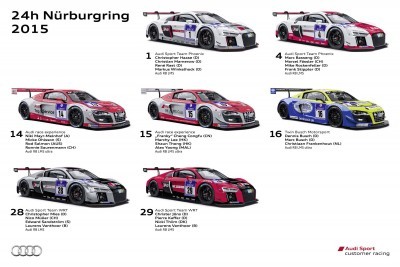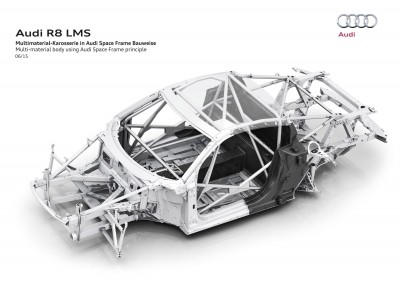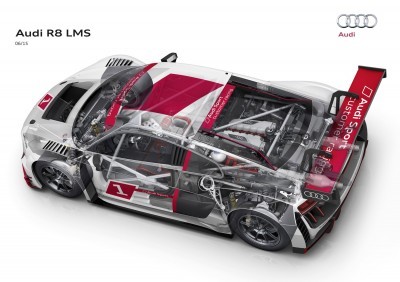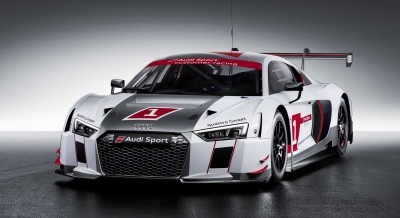The new R8 is big news, of course, for supercar shoppers. Three models are set for the US range: the R8, R8 V10 and R8 V10 Plus. All sport AWD as standard and curb weights of 3500- and 3600-pounds.
America will miss out on the limited-release R8 E-Tron but we will definitely see the fifth family member: the nearly unbeatable 2016 R8 LMS.
This factory racecar is already outselling the existing model among dozens of top-tier sportscar racing teams. The reasons are simple: it is faster than ever thanks to cunning new aero and mechanicals.
The biggest changes versus the V10 Plus road cars? Two major things:
— the LMS is rear-drive only versus the standard 40:60 quattro torque split for all other R8s.
— the LMS is MASSIVELY lighter: just 2700-pounds makes its 585-horsepower feel like 1000+.
The aero package is intense: this is basically a shell racecar when it comes to the bodywork. 50-percent of the overall R8 parts are said to be shared across the road/race divide… but that is mostly a nominal figure. The bodywork, for example, is now fully CRFP versus the aluminum of the road car for every panel except the roof.
So many things from the original R8 are just chucked wholesale — including the entire front subframe, now sporting new crash structures and extreme downforce from lower overall speeds. It is sucked down to the pavement harder than ever, and without crossing 100-mph or so. The new aerokit will start working hard from just 60-mph or so.
Interesting details on the nose, with sliced front fenders and a unique vacuum-effect piece for the upper hood. There is a sharp upward spoiler ahead of the windshield and cabin compartment. The aero theory is to create a suction effect. The negative pressure point pulls air up from the main intake channels of the mostly-solid nose.

The new nose lets the cabin ventilation improve radically versus the current LMS car. Other driver-comfort tweaks include individual adjustments for the pedals and steering wheel, plus a much-lighter and quicker six-speed sequential transmission. Not just kind additions for fatcats — this endurance racer is a long-term home for drivers, and needs to be comfortable to avoid stressing their muscles and joints over hours of racing heat. Comfort = podiums!
Around the profile and into the tail, you can really see how all the new CFRP panels give massive room to pull air through their radiators, over the brakes and into the engine in back.
New rear fender treatments hang the outer bodywork far from the main silhouette of the R8. These free-standing wings and the new-shape tail are multi-functional: aiding the underody downforce ground effects and also venting huge heat from the engine.
The all-new aero is likely the single biggest improvement: the drag coefficient is down 20-percent versus the current R8 LMS — even while upping the downforce dramatically. A smaller rear wing delivers the stickiness in back this year — and is sleeker for higher overall V-maxes.
Pricing and global sales of the R8 LMS are open now: $400k buys you the most intimidating GT3 car on any racetrack in 2016. $50k more and they will fill another DHL aircrate full of parts!
2016 Audi R8 LMS
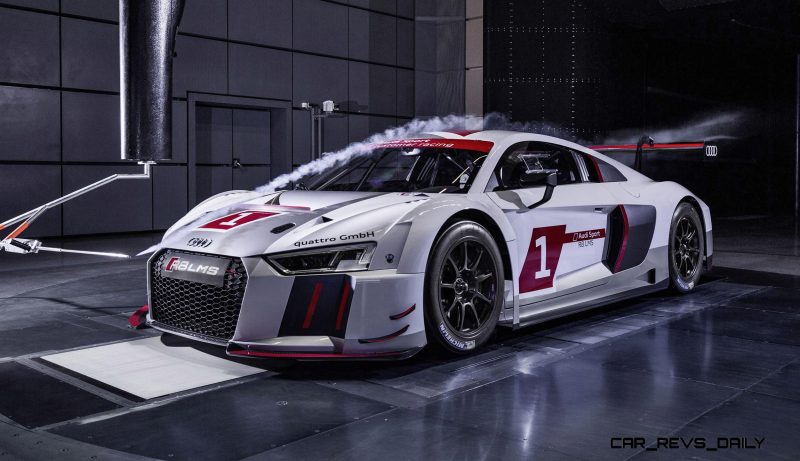
The new Audi R8 LMS
Making its debut at the same time as the new Audi R8 production car model is the motorsport version – the new Audi R8 LMS. Engineers from motorsport and production collaborated closely in its development. As in the first generation of the sports car, the level of shared parts between the two R8 versions is around 50 percent – in addition, both cars have made significant performance gains. The body of the R8 LMS is manufactured together with the production car body at the new Audi Böllinger Höfe handcrafted manufacturing site located near the Audi Neckarsulm plant.
The body of the GT3 race car is based on the point-reinforced multimaterial Aluminum Space Frame (ASF) made of aluminum and carbon fiber reinforced polymer (CFRP), which is supplemented by a safety cage. The Audi PS1 safety seat is solidly joined to the chassis, which increases rigidity. The steering column and pedals can be individually adjusted. A new type of CFRP element in the rear body – similar to the one used on the R8 e-tron – protects the driver in case of a rear-end collision. With the exception of the roof, the exterior skin consists of CFRP, and the homologation weight of the rear-wheel drive race car is 1,225 kg (2700.7 lb).
The V10 engine is nearly identical to the production car engine; it only lacks manifold injection. It outputs around 430 kW (around 585 hp) – depending on the specific race regulations and the air restrictor that is specified in them. The engine rebuild interval is 20,000 km (12,427.4 mi). The newly designed six-speed transmission, which is pneumatically shifted via paddle shifters, is considerably lighter than the previous unit; the clutch features electro-hydraulic activation. Classic race car wishbones guide the wheels, which are size 18-inch according to race rules. The race car also uses special steering components and wheel bearings.
One of the top qualities of the new Audi R8 LMS, which is 4.58 meters (15.0 ft) long and 1.17 meters (3.8 ft) high, is its aerodynamic efficiency. The large diffuser in the large smooth surface of the underbody panels generates strong downforce, which enables a smaller rear wing – compared to the previous model the aerodynamic drag coefficient has been reduced by 20 percent. The flow of cooling air has been improved in all areas – in the front body and in the cockpit.
Today, the new Audi R8 LMS already conforms to GT3 race regulations that take effect in 2016. This year, the new race car will be put through its initial paces by the factory team at international races. The R8 LMS has already won its debut entry at the long-established 24-hour race on the Nürburgring. Audi will be offering the car to interested customer teams from the end of the season.
Technical data Audi R8 LMS (2016*)
| Version: February 2015 | |
| Model | Audi R8 LMS (2016) |
| Vehicle | |
| Vehicle type | Sports car complying with FIA GT3 regulations |
| Chassis | Audi Space Frame (ASF) in aluminium-CFRP hybrid construction with |
| stressed steel roll-cage, bodywork parts from CFRP and aluminium | |
| Safety concept | Energy absorbing aluminium and CFRP crash structures front and rear. |
| Safety concept fulfils FIA LMP1 crash requirements. | |
| Audi Sport PS 1 safety seat | |
| Engine | |
| Type | 90 degree V10 engine, 4 valves per cylinder, |
| DOHC, gasoline direct injection, | |
| emission control by two exhaust gas race catalytic converters | |
| Engine management | Bosch Motorsport Motronic MS6.4 |
| Engine lubrication | Dry sump |
| Cubic capacity | 5,200 cc |
| Power | Variable by restrictor up to 430 kW (585 hp)** |
| Torque | Over 550 Nm |
| Drivetrain/transmission | |
| Transmission type | Rear wheel drive, traction control (ASR) |
| Clutch | Electro hydraulically activated 3-plate race clutch (ECA) |
| Gearbox | Sequential, pneumatically activated 6-speed racing gearbox |
| with paddle shift | |
| Differential | Limited-slip rear differential, variable preload |
| Driveshafts | Constant velocity joints |
| Suspension/steering/brakes | |
| Steering | Servo assisted rack and pinion steering |
| Suspension | Front and rear independent suspension. Double wishbones, |
| damper struts with coil springs and adjustable dampers | |
| as well as adjustable front and rear anti-roll bars | |
| Brakes | Hydraulic dual circuit brake system, |
| steel brake discs front and rear, race ABS | |
| Wheels | Forged aluminium wheels, |
| front 12.5 x 18 inch, rear 13 x 18 inch | |
| Tyres | Front 30-68/18, rear 31-71/18 |
| Weight/dimensions | |
| Length | 4,583 mm |
| Width | 1,997 mm |
| Height | 1,171 mm |
| Homologation weight | 1,225 kg |
| Fuel tank capacity | 120 l |
| Equipment | |
| Fire extinguisher system | Audi Sport |
| Controls | Height and length adjustable safety steering column, |
| quick adjust rail mounted pedal box | |
| Seat system | Audi Protection Seat PS 1 |
- Market launch 2016
- Determined by BoP of event organisers
Paul Ricard Photo Credits: Endurance-Info.com

Tom Burkart is the founder and managing editor of Car-Revs-Daily.com, an innovative and rapidly-expanding automotive news magazine.
He holds a Journalism JBA degree from the University of Wisconsin – Madison. Tom currently resides in Charleston, South Carolina with his two amazing dogs, Drake and Tank.
Mr. Burkart is available for all questions and concerns by email Tom(at)car-revs-daily.com.


